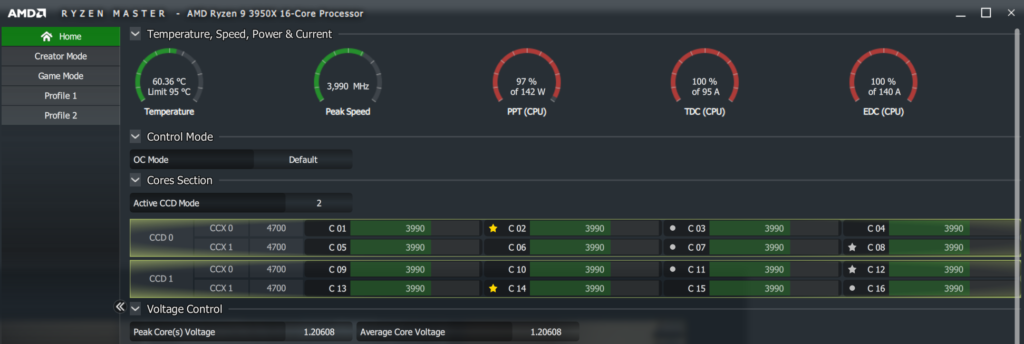Boost Clocks and Ryzen Master
Before the days of boost clocks, a CPU’s clock speed was a set value from the factory. If you had a Pentium 200MHz processor, then you could easily measure the cooling solution by your CPU temps and that’s all you needed to do. When loaded, the CPU’s clocks were a fixed value. Even when overclocking, older CPUs still had a fixed maximum clock speed and once your cooling could no longer extend the clocks, you were at a point where you could determine which cooling solutions were good enough or could be considered overkill.
These days, clock speeds are dynamic. A CPU no longer has a set clock speed value. Instead, you are given a base clock as a minimum standard of what you can expect under load. Then, you are given a boost clock value which is what the CPU can achieve under certain ideal conditions. There are no guarantees you’ll ever see these clock speed values nor are there stipulations on how long the CPU will hold that value or even any guarantees on precise conditions which will result in a given clock speed. We do know how to trigger these conditions for test purposes but there are a lot of variables here and what you get varies by individual configuration and even by specific CPU.
Your CPU’s boost clock behavior is determined by a number of factors. EDC, PPT, and TDC. They are electrical design current, power package tracking, and thermal design current. One additional factor is CPU temperature. If you hit the limits, it will drop the clocks to a lower range to reduce not just temperatures, but in order to keep EDC, PPT and TDC within a certain operational range. It is important to note that the EDC, PPT and TDC values are set by AMD at the factory for these CPUs. There are precision boost 2 values and PBO values. The latter is set by the motherboard or the user and are obviously more generous and allow the CPU to reach higher clocks conditions permitting.
Auto-Overclocking and Precision Boost Overdrive
During initial testing and benchmarking, I don’t use Ryzen Master at all beyond its monitoring functions. There is no need to as Precision Boost 2 is the default operating behavior of these CPUs. All you really need to do is set the defaults for your BIOS and then tune your RAM, boost settings, etc. and your off to the races.
Under Precision Boost 2, I saw the following in Ryzen Master:
Above, you can see under load, I have a clock speed of about 3.990GHz under full load and temperatures below 68c. The values that govern boost clocks are PPT, TDC, And EDC. As you can see these are at 97%, 100%, and 100% respectively. The slightly lower clocks compared to the 3900X make sense given that the 3950X has more cores and the same TDP ratings. To be clear, the clock speeds varied under PB2 depending on the application. As stated earlier, I did see 4.1GHz routinely but the result was closer to 4.0GHz in anything heavily multi-threaded. The temperatures are excellent, so our boost clock limitations lie in the PPT, TDC and EDC limits. After doing testing with PBO, I reset Ryzen Master to “Auto-Overclocking” within the application which resulted in the following:

As you can see, the clock speed is now 4.12GHz in the same test and the temperature has increased to 76.11c. Our PPT, TDC and EDC numbers have much bigger numbers and lower percentages. This shows us that AMD’s conservative values limit the boost clocking range under multi-threaded workloads considerably. Through automatic overclocking the PPT, EDC and TDC limits are raised allowing for much better boost clock behavior. Though technically, this is a form of overclocking.

As it turns out, Auto-Overclocking and PBO in Ryzen Master might as well be the same thing. You get the same 500w, 245A and 280A limits for PPT, TDC and EDC respectively in both. The above screenshot was taken under PBO mode and again, you can see the same PPT, TDC and EDC values. Our clocks in Cinebench R20 are actually slightly worse here as you can see.
Of course, you can go into the BIOS and adjust the values in the PBO menus to increase these, however, in my experience doing so accomplishes nothing. Slight or wild increases have no discernable impact either way.
On AMD’s website specifications for some of its processors, the max temp rating is 68c. This value isn’t shown for all of its CPU’s either. but I think this actually applies to all Ryzen CPUs. I say that for a couple of reasons. I don’t think it’s a maximum temperature rating, but rather a specific target temperature under PB2 which would make sense. For all the Ryzen 3000 series variants I’ve tested, I’ve never seen any of them break 68c at “stock” settings. However, the fact that you have the additional PB2 in Ryzen Master can easily lead to confusion, which is why I’m discussing it here. Under Auto-overclocking or PBO, the temperature ceiling is raised significantly.

